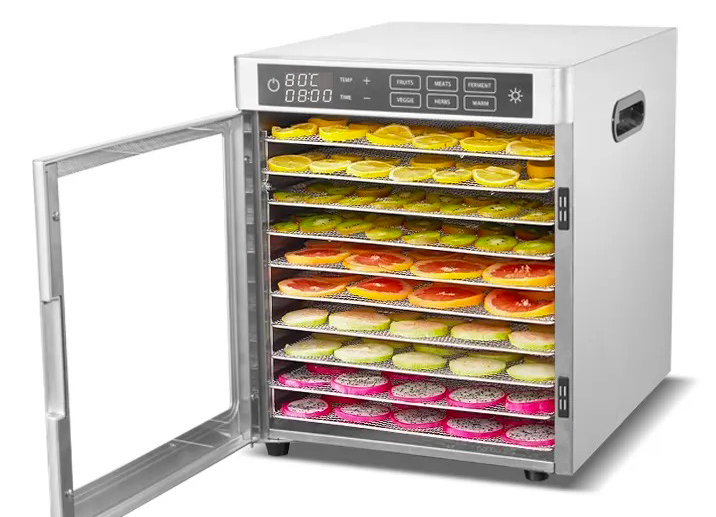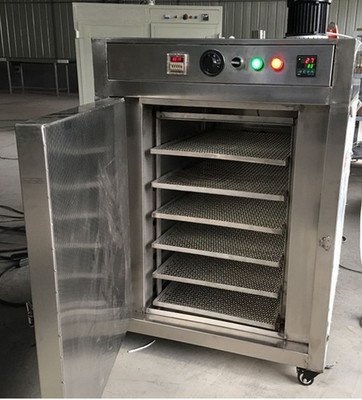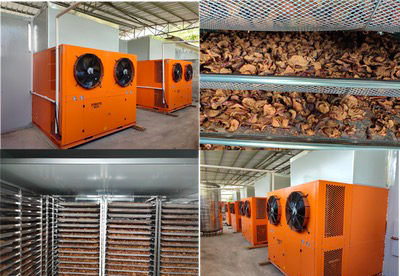
Content Menu
● Introduction
● Understanding Food Dryers
>> What is a Vented Dryer?
>> What is a Heat Pump Dryer?
● Vented Dryer vs Heat Pump: Key Differences
>> 1. Energy Efficiency
>> 2. Drying Time
>> 3. Cost
>> 4. Space Requirements
>> 5. Environmental Impact
● Choosing the Right Food Dryer for Your Needs
● Benefits of Using Food Dryers
>> Nutritional Benefits of Dried Foods
>> Economic Advantages
● Maintenance Tips for Food Dryers
● Innovations in Food Drying Technology
● Conclusion
● Related Questions
>> 1. What foods can be dried using a food dryer?
>> 2. How long does it take to dry food with a vented dryer?
>> 3. Are heat pump dryers suitable for commercial use?
>> 4. What maintenance do food dryers require?
>> 5. Can I use a home dryer for commercial food drying?
Introduction
In the world of food preservation, drying is one of the oldest and most effective methods. Food dryers have become increasingly popular among manufacturers, wholesalers, and brands looking to preserve fruits, vegetables, and meats without compromising their nutritional value. This article explores the differences between vented dryers and heat pump dryers, focusing on their applications in the food drying industry. We will also delve into the benefits of using food dryers, maintenance tips, and factors to consider when choosing the right dryer for your business.

Understanding Food Dryers
Food dryers are appliances designed to remove moisture from food products, thereby extending their shelf life and enhancing flavor. There are various types of food dryers available on the market, but two of the most common types are vented dryers and heat pump dryers.
What is a Vented Dryer?
A vented dryer operates by blowing hot air into the drying chamber. This hot air circulates around the food items, evaporating moisture. The moisture-laden air is then expelled outside through a vent. Vented dryers are typically more straightforward in design and are often less expensive than heat pump models.
Advantages of Vented Dryers:
- Faster Drying Times: Vented dryers can achieve higher temperatures quickly, allowing for faster drying cycles.
- Lower Initial Costs: Generally, vented dryers have a lower purchase price compared to heat pump models.
- Simplicity in Operation: These dryers usually have fewer components, making them easier to operate and maintain.
What is a Heat Pump Dryer?
Heat pump dryers utilize a different technology. They work by extracting moisture from the air inside the drying chamber and then using a heat exchanger to warm that air before recirculating it back into the chamber. This method is more energy-efficient as it reuses the heat generated during the drying process.
Advantages of Heat Pump Dryers:
- Energy Efficiency: Heat pump dryers consume less energy because they recycle air within the system.
- Gentler Drying Process: The lower temperatures used in heat pump dryers help preserve nutrients and flavors in food.
- Compact Design: These dryers often have a smaller footprint, making them suitable for facilities with limited space.
Vented Dryer vs Heat Pump: Key Differences
To help you understand which type of dryer may be more suitable for your needs, let's compare vented dryers and heat pump dryers based on several critical factors.
1. Energy Efficiency
- Vented Dryers: These tend to consume more energy because they continuously draw in new air and expel moisture-laden air outside. This process requires more energy to maintain high temperatures.
- Heat Pump Dryers: These are generally more energy-efficient as they recycle air within the system, reducing energy consumption significantly.
2. Drying Time
- Vented Dryers: They usually have faster drying times due to their ability to maintain higher temperatures consistently.
- Heat Pump Dryers: While they may take longer to dry food compared to vented dryers, they provide a gentler drying process that can preserve more nutrients.
3. Cost
- Vented Dryers: Typically less expensive upfront but may incur higher operational costs due to energy consumption.
- Heat Pump Dryers: Higher initial investment but lower running costs over time due to their energy efficiency.

4. Space Requirements
- Vented Dryers: Require adequate ventilation space for exhaust; this can limit placement options in smaller facilities.
- Heat Pump Dryers: More compact and do not require external venting, making them suitable for smaller spaces.
5. Environmental Impact
- Vented Dryers: The continuous expulsion of warm air can increase energy consumption and environmental footprint.
- Heat Pump Dryers: More environmentally friendly due to lower energy usage and reduced greenhouse gas emissions.
Choosing the Right Food Dryer for Your Needs
When deciding between a vented dryer and a heat pump dryer for your food processing business, consider the following factors:
- Volume of Production: If you have high production needs, a vented dryer might be more suitable due to its faster drying capabilities.
- Energy Costs: Evaluate your local energy rates; if electricity is expensive, a heat pump dryer could save you money in the long run.
- Available Space: Ensure you have enough space for installation. If space is limited, heat pump dryers may be advantageous.
- Product Type: Consider what types of foods you will be drying. Delicate items may benefit from the gentler drying process of heat pump dryers.
Benefits of Using Food Dryers
Food dryers offer numerous benefits for businesses involved in food production:
- Extended Shelf Life: Properly dried foods can last for months or even years without refrigeration.
- Nutritional Retention: Advanced drying techniques help retain vitamins and minerals in food products.
- Flavor Enhancement: Dried foods often have concentrated flavors that can enhance culinary dishes.
- Reduced Waste: By preserving surplus produce through drying, businesses can minimize waste and maximize profits.
Nutritional Benefits of Dried Foods
Dried foods retain most of their nutrients when dried properly. For instance:
- Fruits like apples and bananas lose minimal vitamins when dehydrated at low temperatures.
- Vegetables such as carrots and spinach retain their minerals and antioxidants through careful drying processes.
Economic Advantages
Investing in food drying technology can lead to significant economic benefits:
- Reduced spoilage costs by extending product shelf life.
- Increased marketability of products like dried fruits or jerky that command higher prices than fresh produce.
- Opportunities for exporting dried foods to markets with high demand but limited fresh produce availability.
Maintenance Tips for Food Dryers
Regular maintenance is essential for ensuring optimal performance from your food dryer:
1. Cleaning Filters Regularly: Dirty filters can reduce airflow and efficiency. Clean or replace filters as needed based on usage frequency.
2. Inspect Seals and Gaskets: Check seals around doors or lids regularly for wear or damage; replacing worn seals can improve efficiency.
3. Monitor Temperature Settings: Ensure that your dryer maintains consistent temperatures throughout the drying cycle; fluctuations can affect product quality.
4. Keep the Exterior Clean: Dust and debris can accumulate on exterior surfaces; regular cleaning helps maintain equipment appearance and function.
5. Schedule Professional Servicing: Consider having your equipment serviced by professionals periodically to ensure all components are functioning correctly.
Innovations in Food Drying Technology
As technology advances, new innovations continue to emerge in the field of food drying:
- Smart Technology Integration: Modern food dryers now come equipped with smart technology that allows users to monitor temperature settings remotely via mobile apps.
- Energy Recovery Systems: Some advanced models utilize systems that recover waste heat from the drying process to preheat incoming air, further enhancing energy efficiency.
- Multi-functional Units: Newer models combine multiple functions such as dehydrating, baking, and even fermenting foods in one unit, providing versatility for food processors.
Conclusion
In conclusion, both vented dryers and heat pump dryers have their unique advantages and disadvantages when it comes to food drying applications. Vented dryers are typically faster and less expensive upfront but may incur higher operational costs. On the other hand, heat pump dryers are more energy-efficient and environmentally friendly but come with a higher initial investment. Ultimately, the best choice depends on your specific needs regarding production volume, space availability, budget considerations, and desired product quality.
By understanding these differences and considering factors such as maintenance requirements and technological advancements, businesses can make informed decisions about which type of food dryer will best meet their needs while maximizing efficiency and profitability.

Related Questions
1. What foods can be dried using a food dryer?
- A variety of foods can be dried using food dryers including fruits (like apples and bananas), vegetables (like tomatoes and peppers), herbs, meats (for jerky), and even flowers for decorative purposes.
2. How long does it take to dry food with a vented dryer?
- The drying time varies depending on the type of food being dried; however, most foods can take anywhere from 6 to 12 hours in a vented dryer.
3. Are heat pump dryers suitable for commercial use?
- Yes, heat pump dryers are increasingly being used in commercial settings due to their efficiency and ability to handle large volumes of food while maintaining quality.
4. What maintenance do food dryers require?
- Regular cleaning of filters, checking seals for leaks, ensuring proper airflow are essential maintenance tasks for both types of dryers.
5. Can I use a home dryer for commercial food drying?
- While home dryers can be used for small batches of food drying, they may not meet commercial standards regarding capacity or efficiency.












